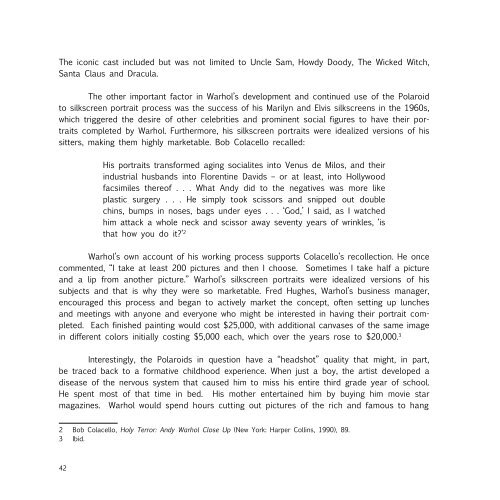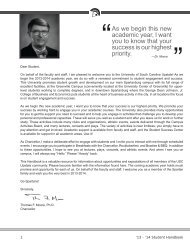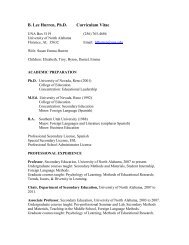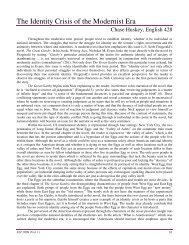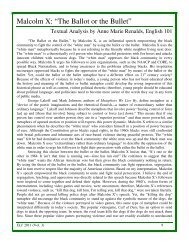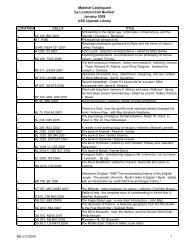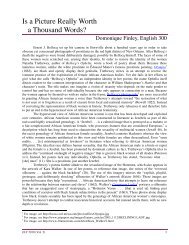The Andy Warhol Photographic - University of South Carolina Upstate
The Andy Warhol Photographic - University of South Carolina Upstate
The Andy Warhol Photographic - University of South Carolina Upstate
Create successful ePaper yourself
Turn your PDF publications into a flip-book with our unique Google optimized e-Paper software.
<strong>The</strong> iconic cast included but was not limited to Uncle Sam, Howdy Doody, <strong>The</strong> Wicked Witch,<br />
Santa Claus and Dracula.<br />
<strong>The</strong> other important factor in <strong>Warhol</strong>’s development and continued use <strong>of</strong> the Polaroid<br />
to silkscreen portrait process was the success <strong>of</strong> his Marilyn and Elvis silkscreens in the 1960s,<br />
which triggered the desire <strong>of</strong> other celebrities and prominent social figures to have their portraits<br />
completed by <strong>Warhol</strong>. Furthermore, his silkscreen portraits were idealized versions <strong>of</strong> his<br />
sitters, making them highly marketable. Bob Colacello recalled:<br />
His portraits transformed aging socialites into Venus de Milos, and their<br />
industrial husbands into Florentine Davids – or at least, into Hollywood<br />
facsimiles there<strong>of</strong> . . . What <strong>Andy</strong> did to the negatives was more like<br />
plastic surgery . . . He simply took scissors and snipped out double<br />
chins, bumps in noses, bags under eyes . . . ‘God,’ I said, as I watched<br />
him attack a whole neck and scissor away seventy years <strong>of</strong> wrinkles, ‘is<br />
that how you do it’ 2<br />
<strong>Warhol</strong>’s own account <strong>of</strong> his working process supports Colacello’s recollection. He once<br />
commented, “I take at least 200 pictures and then I choose. Sometimes I take half a picture<br />
and a lip from another picture.” <strong>Warhol</strong>’s silkscreen portraits were idealized versions <strong>of</strong> his<br />
subjects and that is why they were so marketable. Fred Hughes, <strong>Warhol</strong>’s business manager,<br />
encouraged this process and began to actively market the concept, <strong>of</strong>ten setting up lunches<br />
and meetings with anyone and everyone who might be interested in having their portrait completed.<br />
Each finished painting would cost $25,000, with additional canvases <strong>of</strong> the same image<br />
in different colors initially costing $5,000 each, which over the years rose to $20,000. 3<br />
Interestingly, the Polaroids in question have a “headshot” quality that might, in part,<br />
be traced back to a formative childhood experience. When just a boy, the artist developed a<br />
disease <strong>of</strong> the nervous system that caused him to miss his entire third grade year <strong>of</strong> school.<br />
He spent most <strong>of</strong> that time in bed. His mother entertained him by buying him movie star<br />
magazines. <strong>Warhol</strong> would spend hours cutting out pictures <strong>of</strong> the rich and famous to hang<br />
around his cot in the living room. Perhaps this is when <strong>Warhol</strong> began to absorb early but<br />
influential lessons regarding visual constructions <strong>of</strong> celebrity and glamour. However, the effect<br />
<strong>of</strong> this intense exposure to popular culture at a young age should not be overemphasized. It is<br />
certainly not the only, or even the most significant life experience that contributed to <strong>Warhol</strong>’s<br />
interest in popular imagery. One thing remains clear, regardless <strong>of</strong> these portraits’ source or<br />
impetus, they reflect the artist’s life-long exploration <strong>of</strong> how people and things become images<br />
and how those images, in turn, become commodities. Sitting for <strong>Warhol</strong> might make one look<br />
famous, but it also entailed submitting one’s image to incessant repetition. Not only did <strong>Warhol</strong><br />
idealize them and turn them into stars in their own minds, he also entered that idealized image<br />
into a system <strong>of</strong> mass reproduction. As this exhibit demonstrates, hardly any <strong>of</strong> the portraits<br />
are singular. This is an important realization because it highlights the fact that each one is significant<br />
not as a finished, unique product, but rather as a process, resulting in multiple phases<br />
and modes <strong>of</strong> production and a wide array <strong>of</strong> outcomes (and products to sell).<br />
A new and deeper appreciation and understanding <strong>of</strong> the Polaroids contained within<br />
this exhibition emerges when comparing the photographic image to its companion silkscreen<br />
portrait. Some <strong>of</strong> the faces are recognizable, such as Pia Zadora (1983) (Fig. 34) and Caroline,<br />
Princess <strong>of</strong> Monaco (1983) (Fig. 9). One <strong>of</strong> <strong>Warhol</strong>’s finished silkscreen portraits <strong>of</strong> the Princess<br />
was used for the December 1983 cover <strong>of</strong> Vogue magazine. Other subjects are less familiar,<br />
such as Suzie Frankfurt (1980) (Figs. 35). Frankfurt worked as an interior designer for the stars,<br />
and met <strong>Warhol</strong> at the Plaza Hotel in 1954 4 . Sharing a similar sense <strong>of</strong> humor, they became<br />
lifelong friends who would <strong>of</strong>ten go antique shopping together. <strong>The</strong>y also collaborated on an<br />
amusing cookbook called Wild Raspberries (1956). Contributions to the book were made by<br />
Frankfurt, <strong>Warhol</strong>, and <strong>Warhol</strong>’s mother, Julia. Frankfurt wrote the recipes, <strong>Warhol</strong> illustrated<br />
the volume, and Julia’s scrawled penmanship and characteristic misspellings made for a delightful<br />
read. <strong>The</strong> work includes such recipes as “Omelette Greta Garbo” with the instructions<br />
“always to be eaten alone in a candlelit room.” 5 Another relatively unknown figure in this<br />
exhibition is Luciano Anselmino. Anselmino was an Italian art dealer who introduced <strong>Warhol</strong> to<br />
the artist Man Ray. <strong>Warhol</strong> traveled to Paris to photograph May Ray for a commissioned silkscreen<br />
and he took several Polaroid portraits <strong>of</strong> Anselmino at the same time (Fig. 39, 17 – 20).<br />
2 Bob Colacello, Holy Terror: <strong>Andy</strong> <strong>Warhol</strong> Close Up (New York: Harper Collins, 1990), 89.<br />
3 Ibid.<br />
4 Mitchell Owens, “Suzie Frankfurt, 73, a Decorator and Friend to <strong>Warhol</strong>, Dies,” New York Times (January 17, 2005).<br />
5 <strong>Andy</strong> <strong>Warhol</strong> and Suzie Frankfurt, Wild Raspberries (Boston: Little, Brown, 1997).<br />
42<br />
43


